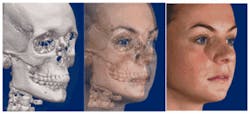Cone Beam TECHNOLOGY
by Paul Feuerstein, DMD
Probably the hottest new technology for dentistry is the cone beam CT scan. All of a sudden, we have the ability to get 3-D, radiographic images of oral structures. It is invaluable for treatment planning in surgery, implantology, and orthodontics. Other applications quickly appear in practitioners’ minds, although we must examine the costs, radiation, and practicality of some of these units for everyday “routine” work.
Basically, cone beam technology allows practitioners to take CT scans in their offices or designated imaging centers, which is quicker, less expensive, and more efficient than typical hospital settings. Most of the units resemble panoramic machines and have a slightly larger footprint.
An initial problem for some practitioners was having to read multiple slices, which brings a learning curve. Thanks to some clever programmers, however, these slices can be reconstructed to look like 3-D images of the teeth, jaws, and even soft tissue.
The TMJ scans of these units are nothing short of remarkable. The reconstructed images combined with the actual slices give accurate information about the condlyar head, wear and tear, and location, aiding in the diagnosis.
Numerous resources explain how the new scanners operate, but suffice it to say that the X-ray head travels around the skull in a path similar to that of the panoramic unit, but it simultaneously “shoots” slices front to back. This graphic should give you an idea. The doses are approximately four to 10 times a panoramic scan, as compared with a CT, which is 80 to 180 times a panoramic dose.
A new wrinkle has been adding a 3-D photo of the patient’s face and head and overlaying this on the scans. It’s an orthodontist’s dream! The skeletal image can be seen in the actual face. Taking it a step further, the software can show the finished case (think of Align’s Invisalign) in the bone, teeth, and patient’s face.
Looking into the future, if the resolution of these scans can get below 50 microns, they may be accurate enough to create dental restorations. Imagine a fully articulated set of teeth with the preparations defined and the actual TMJ as the hinge of the articulator all taken externally!
The marketplace, which once had three or four units, has now become a hotbed of technological introductions. Many traditional manufacturers of radiographic products now have their logos on these new entrees. Other less-familiar names such as Imaging Sciences and TeraRecon are actually leaders in this arena. The chart on the following pages is as current as possible. (We realize changes are possible between time of publishing and when this issue hits hands of DE readers.)
Cone Beam CT ROI
How can an office justify spending almost $200,000 on a piece of equipment? One solution is by offering scans to other offices for fees. Certainly a specialist could do this more easily than a GP because of the referral structure, but in some states, a dentist can open up a “scan center” business. If not, there are usually enterprising people who can set these up in partnership with a dentist. Some successful centers already exist in cities such as Boston, Atlanta, and Dallas.
Assuming the purchase is made over time, a lease for example, the monthly payment is approximately $3,500 a month for 60 months. Using a conservative figure of $350 per scan, the center needs to do 10 per month to pay that note.
More scans will begin to yield a profit. If there are enough GPs, orthodontists, oral surgeons, and periodontists who have a need for these scans in a general area, this could be a reality. The obvious areas for diagnosis are implant planning, surgical pre-op, and orthodontic considerations. As the use of these scans becomes more apparent, referrals will increase. Note: Fees in excess of $600 per scan are charged in some areas. Click here to view tables.
Dr. Paul Feuerstein installed one of dentistry’s first computers in 1978. For more than 20 years, he has taught technology courses. Dr. Feuerstein is a mainstay at technology sessions, including annual appearances at the Yankee Dental Congress, and he is an ADA seminar series speaker. A general practitioner with an office in North Billerica, Mass., since 1973, Dr. Feuerstein maintains a Web site at www.computersindentistry.com. Reach him by e-mail at [email protected].


